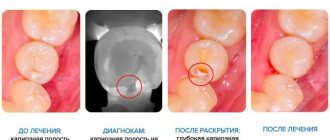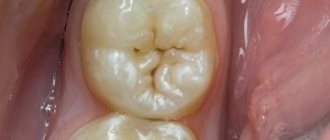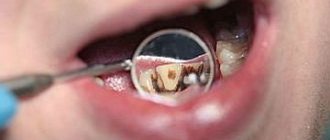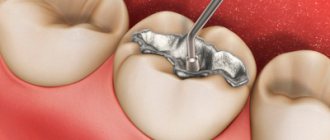When communicating with some people, it is impossible not to pay attention to the strange, unnatural and sometimes even frightening color of teeth. Sometimes a yellowish or grayish tint appears on them. It happens that brown spots appear directly on the teeth. All this, as a rule, indicates so-called pigmentation. How does it manifest itself, where does it come from and how to deal with it? These are, perhaps, the main questions that concern people who have encountered similar phenomena. In order to understand how to deal with such a problem, we must penetrate into its essence, find out for ourselves what are the known causes of tooth pigmentation.
External pigmentation on teeth
Among dentists, causes are usually divided into external and internal. Let's start, perhaps, with external factors. These usually include those substances that we use in everyday life, which externally stain the tooth, penetrating into the pores of its enamel.
The most dangerous factor can be called smoking, because the nicotine resins contained in tobacco give the enamel an unpleasant yellowish-brown tint. A similar substance in its effects is coffee. It is also impossible not to mention strong black tea and red wine. They also play an important role in destroying tooth enamel and giving it an unaesthetic appearance.
We must not forget about the huge number of food dyes, in which the coloring pigments cause damage. And, of course, one cannot fail to mention the stones and plaque that arise due to violation of oral hygiene rules, lack of minerals in the body and a minimal amount of solid food or even its absence in the diet. External manifestations of pigmentation on teeth are not difficult to eliminate. All you need is advice from a dentist. You will also need to use the right toothpaste.
Enamel color depending on the cause of the problem
| Color | Possible cause of the pathology |
| Yellow | Accumulation of soft plaque due to poor hygiene. Jaundice. Taking tetracycline and antibiotics. Internal diseases of the body (for example, damage to the gastrointestinal tract) |
| Pinkish | Damage to the pulp as a result of trauma. Canal filling with resorcinol-formalin |
| Brown | Smoking (the coating may be dark brown or even black). Hard mineralized plaque. Abuse of strong coffee and tea. Brown spots may indicate caries, wedge defect or fluorosis |
| Black | Taking iron supplements. Priestley's plaque in children. Pathologies of internal organs |
| Grey | Necrosis and death of the pulp. After depulpation |
White chalky spots may also appear on the enamel, indicating processes of demineralization of hard tissues, hypoplasia or the superficial stage of caries.
Internal pigmentation
The situation is much more complicated with internal pigmentation, because then the internal hard tissue of the tooth is already stained. There can be a huge number of reasons for such changes in the oral cavity. One of the most common is a change in the balance of fluoride in the body. Why? Fluoride has a destructive effect on teeth, since the tissue changes its color depending on its lack or excess.
Stories are replete with cases where all the villagers had the same stains on their teeth because all the villagers drank water from the same underground springs. In some cases, staining of tooth enamel occurs due to the use of tetracycline antibiotics. It also happens that the cause of such a problem can be a filling placed as a result of dental surgery, provided that the material was made of copper amalgam.
For some, pigmentation comes with age. Hereditary factors also play a role. In children, pigmentation on the teeth can also be due to an improper diet and a sharp change in temperature in the oral cavity, for example, when consuming cold food immediately after hot food.
When black caries still needs to be filled?
You need to clean a black spot using a drill if:
- the patient complains of increased sensitivity to sour, salty and sweet foods, temperature changes;
- when there is mechanical impact on the damaged crown, pain occurs;
- the hole is growing in size too quickly;
- the speck is located in the area of the neck of the tooth;
- there was an unpleasant odor from the mouth;
- The black defect is localized on the incisors and spoils the smile.
In all these cases, the fight against carious lesions is carried out according to the classical scheme. The patient is injected with an anesthetic, after which the carious lesion is cleaned from altered tissues using a drill. The cleaned area is treated with an antiseptic and filled with a filling solution. The latter is dried with a lamp and then sanded to achieve the correct shape and perfect smoothness. As a result, the unit begins to look aesthetically pleasing, and its service life increases significantly.
Diagnostics: what methods are used in dentistry?
Science, unfortunately, has not yet made big strides in diagnosing dental pigmentation. Limitations in laboratory and clinical research, the lack of availability of high-quality and modern equipment affect the efficiency of dentists.
But, despite all the obstacles, in our country there are a huge number of specialists endowed with intelligence and experience who, after conducting only a visual examination of the patient, will be able to accurately diagnose pigmentation on the teeth. Although there are often cases when in diagnosis it is necessary to resort to modern technologies, such as radiography or orthopantomography, with the help of which the dentist studies the internal problems of damaged teeth.
Doctors have a large number of other devices and methods in their arsenal that are used in particularly difficult situations. These include, for example, microscopy or rheodentography. They allow the specialist to examine the problem in more detail. And in the study of tissues such as gums or blood vessels, a device called a reparodontograph is often used.
Diagnosis and treatment
Only a dentist can determine the exact cause of blackening of the tooth root. To identify the provoking factor, doctors use different diagnostic methods:
- inspection,
- dental radiography,
- electroodontometry.
The treatment regimen is drawn up individually for each patient, taking into account the clinical picture. If you have tartar, professional teeth cleaning is recommended. If the darkening of the enamel is caused by caries, it is necessary to clean the carious cavity and install a filling.
Is it necessary to treat such an illness?
How many people plan to treat tooth pigmentation? Most people consider the problem to be purely cosmetic. There are many reasons for such negligence on the part of patients. This includes illiteracy, arrogance, carelessness, and often, of course, fear. It always seems to the average person that now he will introduce more vegetables and dairy products into his diet, start using more expensive toothpaste, and the problem will be eliminated. But it won't work that way.
The color of the teeth will not acquire the desired snow-white shade. If such a problem arises, you should immediately contact a specialist, and the sooner you do this, the better for you. Moreover, both from the aesthetic and material side. Using special equipment, a dentist can easily rid you of external plaque on tooth enamel, identify the internal cause of pigmentation and, accordingly, prescribe a specific course of treatment in order to eliminate not only the symptoms of the disease, but also the disease itself.
Recommendations from Amel Dental dentists
Beautiful teeth are healthy teeth, and dental health is the result of a patient’s responsible attitude towards their health and oral hygiene.
You can avoid the appearance of unsightly pigment spots on your teeth by following the recommendations of dentists:
- to give up smoking;
- restriction in the diet of coloring drinks and foods;
- restriction in the diet of foods containing acid (citrus fruits, apples);
- balanced diet (sufficient amounts of calcium, vitamin C and other minerals, vitamins necessary for the formation of bone tissue), high-quality drinking water;
- Regular visits to dentistry for the purpose of prevention and timely treatment of caries and other oral diseases.
If stains appear on your teeth, you should not self-medicate, since in most cases, aesthetic defects of the teeth are associated with disorders and diseases within the body. Only a qualified doctor can determine the cause of the pathology and prescribe the correct treatment.
Colgate Simply White Night Gel
The list of common treatments is relatively small and is available to everyone. Most drugs are undesirable to use without the advice of a specialist. However, what to do when there is not always enough free time to visit the dentist, and the problem requires an immediate solution due to certain life circumstances? In such cases, you can rely on some cosmetic products, such as some toothpastes or gels.
There are an endless number of different options, but the most popular among ordinary consumers is Colgate Simply White Night gel. A group of scientists was given a task: how to whiten teeth without harming the enamel, and to do it in such a way that everyone could do it at home.
The method of application is extremely simple, as it was created from the point of view of maximum comfort.
How to use the gel?
To begin, you simply need to clean your tooth enamel using standard methods, such as a toothbrush and toothpaste. This is necessary so that there are no excess bacteria in the oral cavity and the space is ready for treatment. Then you should dry each tooth with a special swab and apply the gel to them.
It is recommended not to eat anything for 15-20 minutes. And thus, within a few days you will notice the result, and after a longer time, your smile will finally acquire that desired shine. The effect of such whitening can be observed for about one year. Then the course must be repeated.
The drug “Gluflutored”
However, not all products are as simple, effective and easy to use as the gel described above. Most drugs can be harmful if used without proper prescription from a doctor, who will instruct in detail and warn against potential risks.
The specialist will tell you how to get rid of external and internal manifestations of pigmentation, how to strengthen tooth enamel and prevent diseases. An effective way to get rid of the problem is to change the chemical composition of saliva by influencing the thyroid gland with a certain set of minerals, vitamins and fluoride for teeth. One of the most common substances used for treatment in clinical settings is Glufluored.
Treatment of a darkened tooth
Darkening of the tooth near the gum requires immediate consultation with a doctor, regardless of the cause. If you leave the disease to its own devices, you can face more dangerous and serious consequences.
The doctors at our regional dental clinic are ready to help. We use modern equipment, progressive therapeutic practices and always put the patient's comfort as a priority. Therefore, treatment of a darkened tooth will be quick and effective. Don’t let the disease lead to dangerous consequences - make an appointment with the dentist!
“Glufluored”: how is it used?
It is applied quite simply. The tooth is washed with water and dried. The substance is applied to the enamel surface and disinfected after a minute. The procedure is usually repeated about twice a year. And although glufluored is inherently harmless, it still cannot be used without careful medical supervision. Because the drug requires an extremely precise order of use, as well as applying a precisely measured amount of the composition. After this procedure, the dentist usually applies bonding to the surface of the teeth.
This drug has an official name, which sounds like Monobond Plus. It helps in restoring and strengthening the connections between the surface of the tooth and the substance applied to it. This remedy is, in principle, harmless for most people. The only exceptions may be individual allergic reactions to certain substances contained in boding. But such incidents are rare.
04.10.2012 14:43- ZOOM4 whitening (+ comprehensive hygiene + set for home whitening and remedial therapy) — 30,000 rub
Causes of tooth discoloration
Discoloration of teeth can occur both from the surface of the teeth and from the pulp cavity. Tooth discoloration is conventionally divided into external (located on the surface of the tooth) and internal (located in the thickness of the tooth). External color changes can become internal over time.
- Widespread superficial staining of teeth with vital pulp is the result of consuming beverages or foods containing high levels of dyes. Tobacco causes a yellow-brown or dark discoloration, usually in the isthmus of the teeth and mainly on the lingual surfaces. When chewed, tobacco quickly penetrates the enamel and forms even darker stains, while marijuana can produce clear rings in the cervical part of the teeth near the gum line. Coffee and tea cause the formation of pronounced and persistent brown or black stains on tooth enamel.
- Internal staining can be caused by medications such as tetracycline. Teeth are most sensitive to tetracycline staining during the period of formation, i.e., from the second trimester of pregnancy until approximately 8 years of age. It is believed that tetracycline molecules are absorbed by dentin during the mineralization of teeth. If tetracycline-stained teeth are exposed to sunlight, they will gradually turn dark gray or brown. Since tetracycline is absorbed by dentin during the period of mineralization of the buds, adults whose teeth have already formed can use antibiotics without the risk of tooth discoloration. However, a semi-synthetic tetracycline derivative used to treat acne has recently been found to cause tooth staining in adolescents. It is believed that tooth pigmentation occurs due to the ability of minocycline to form chelates with iron and create insoluble complexes.
- In areas where drinking water contains large amounts of fluoride, children during the period of enamel development and mineralization of tooth germs can absorb excess amounts of fluoride, which causes disruption of ameloblast metabolism, leading to the formation of a defective matrix and improper mineralization - endemic enamel fluorosis. There are two types of dental damage caused by fluorosis: discoloration and surface defects. Affected teeth usually have a shiny surface and may be papery white with areas of yellow or brown (sometimes black) discoloration.
- Fillings and restorations also often cause discoloration of teeth. Destructuring of tooth-colored restorative materials, such as acrylics, glass ionomer cements, or composites, causes the tooth to appear gray or less saturated over time. Metal fillings and inlays made of amalgam, alloys of silver and gold, can be visible through the enamel.
- Oils, iodine compounds, nitrates, root canal filling materials, pins and other materials used in restoration can also cause tooth discoloration. The degree of staining of teeth is determined by the length of time during which these substances penetrated into the dentinal tubules.
- Teeth staining can also occur due to systemic diseases. Although there are many genetic or childhood diseases that change the color of teeth, most are rare.
Examples of such conditions are:
- Green-blue or brown discoloration of primary teeth, observed in children who suffered hemolytic jaundice in infancy. These stains are the result of postnatal staining of dentin with bilirubin and biliverdin.
- A characteristic brown staining of teeth caused by the destruction of a large number of red blood cells during erythroblastosis fetalis as a consequence of the incompatibility of Rh factors of the fetal matter.
- Red-brown discoloration of teeth in people suffering from porphyria, a very rare disease in which an excess amount of pigment is produced.
- Changes in the color, shape and structure of teeth almost inevitably occur as we age. The nature and extent of such changes depend on a combination of genetic factors, lifestyle and various bad habits. Years of smoking and drinking coffee have a cumulative staining effect. These and other types of plaque become even more noticeable due to the inevitable formation of cracks and other changes in the surface of the teeth within their crystalline structure, in the underlying dentin and pulp. In addition to abrasion and injury to teeth, old amalgam fillings and other restorations may begin to deteriorate. Even with a very careful approach to these problems, teeth will change color with age due to natural wear, as well as as a result of exposure to the oral environment. Initially, thinning of the enamel usually occurs. In this case, the buccal surface of the tooth becomes flatter and due to the loss of the transparent enamel layer, a gradual change in the color of the tooth occurs. When the enamel becomes thinner, a natural defense mechanism in the dentin and pulp begins the process of forming secondary dentin. This increased mass of dentin begins to darken. Thin enamel combined with darkened dentin gives teeth an “older” appearance.
- White spots, symmetrically located on the teeth of the same name, may be a symptom of enamel hypoplasia. One of the features of hypoplasia spots is that they are not stained with dyes, and the outer layer of enamel remains smooth and shiny. Chalky teeth can be a result of excessive whitening and prolonged use of soda for this purpose. Small chalky stripes - streaks located in the subsurface layers of the enamel are characteristic of the streaked form of fluorosis. The spotted form of fluorosis is characterized by the presence of chalky spots without stripes. The chalky-mottled form of fluorosis is distinguished by significant diversity. Typically, tooth enamel has a matte tint, and against this background pigmented spots with clear boundaries are visible. Sometimes a large number of spots and dots are found on the enamel. A pronounced whitish color may be due to dense plaque formed as a result of insufficient or improper individual oral hygiene.
- Depulped teeth lose their characteristic shine and acquire a more grayish tint. A similar, and sometimes more intense, color change is observed in teeth with pulp necrosis. Gray coloration can also be caused by poisoning with heavy metals - mercury and lead.
- Teeth with a greenish tint appear when their surface is damaged by specific fungi. Green staining can occur when a tooth comes into contact with copper amalgam fillings. Yellow teeth can be a result of exposure to bromine and iodine fumes, as well as constant consumption of strong tea and coffee. A dark brown border often appears in smokers. Dark brown (even black) color of teeth can appear due to professional contact with metals (manganese, iron, nickel). A change in the color of the tooth crown can occur immediately after an injury, especially in the cervical area on the palatal side, where the enamel layer is thinner, which is a diagnostic sign of injury. Thus, tooth discoloration clinically manifests itself in a wide variety of shades.
Teeth whitening
Changing the color and brightness of teeth is one of the most frequently requested procedures by patients from the dentist today. Geographically, all modern teeth whitening technologies originate from the United States of America.
At different times and different peoples had their own idea of beauty. And what one culture perceives as beautiful, another may consider ugly. For example, in Japan, more than 4 thousand years ago, there was a tradition of decorative staining of teeth. This procedure was considered cosmetic, and its main result was to give the enamel of the teeth a dark brown color.
Harmony of color, together with integrity, symmetry and proportionality, is the basic criterion for aesthetics in composition. Therefore, patients believe that among the factors influencing the attractiveness of a smile, the color of the teeth is the most important. The demand for cosmetic services has increased dramatically in recent years everywhere.
It is necessary to distinguish between the concepts of teeth whitening and teeth whitening.
→ Teeth whitening
This is the return of their natural color due to the mechanical removal of surface pigment deposits. Teeth whitening occurs due to the removal of supra- and subgingival dental plaque with ultrasound. Removing dental plaque using the Airflow device. Polishing teeth with brushes with special abrasive pastes. These manipulations will lighten your teeth to the natural color given to you by nature.
→ Whitening
- this is already a change in the shade of the tooth due to the release of atomic oxygen, which penetrates the enamel and dentin of the tooth and breaks down the pigment. There are several methods of teeth whitening. All professional whitening methods are divided into clinical (the procedure is performed by a dentist in a dental office) and home (the patient independently uses trays with whitening gel at home). Clinical whitening systems come with light and chemical activators. Traditionally, hydrogen peroxide is used in clinical systems - 25 -38%. Such systems can whiten teeth up to 15 shades. Home systems contain lower percentages of hydrogen peroxide up to 10%. The effectiveness of home whitening is significantly lower - from 1 to 8 tones. As for the agents that form the basis of any bleaching system, nothing fundamentally has changed since 1884, when Harlan first proposed the use of hydrogen peroxide. The advantage of professional whitening is that the procedure is carried out and supervised by a doctor.
Indications for teeth whitening
- The patient's desire to make his teeth lighter.
- Mild and moderate form of fluorosis.
- Age-related changes in tooth color (yellowing).
- Coloring as a result of bad habits.
- Penetrating staining from frequent consumption of coloring foods and drinks.
Contraindications
Are common
- Patient's age (minor children and adolescents).
- Pregnancy and breastfeeding.
- Allergic reactions to whitening components.
- Taking light-sensitive drugs such as doxycycline, tretinoin, ciprovloxacin, hydrochlorothioside, etc.
- General diseases: cancer and endocrine diseases, bronchial asthma, hypertension.
- Inflated patient expectations from the whitening procedure.
Local
- The presence of carious cavities, fillings, restorations, crowns in the whitening area.
- Wide pulp chamber.
- Enamel hyperesthesia (increased sensitivity of teeth).
- Significant loss of enamel as a result of pathology and age.
- Acute and aggravated periodontal diseases.
- Diseases of the oral mucosa.
- Diseases of the temporomandibular joint accompanied by limited mouth opening.
- The patient has a pronounced gag reflex.
Possible complications
- The appearance of hyperesthesia (can last from several hours to several days). To eliminate it, it is necessary to conduct a course of retherapy before and after the whitening procedure. The use of desincitizers, special rinses and toothpastes for sensitive teeth.
- Irritation of the oral mucosa (burning).
- Color regression. Within 2 weeks after the whitening procedure, the oxidation process causes a change in the optical qualities of the tooth, giving it a more opaque appearance. After 2 weeks, the oxygen dissipates and the tooth acquires a real light shade.
- Change in taste sensations. It is temporary.
To maintain the results obtained, the patient must follow the following recommendations:
- Follow the rules of personal oral hygiene every day.
- In the first 48 hours after the whitening procedure, do not eat foods with coloring, and in the next 2 weeks follow a clear diet.
- Visit the dentist regularly at least once every six months.
- Repeated course of whitening after 1.5-2 years (if necessary).
Scheme of the teeth whitening procedure
- Questioning
- History taking
- Determining the cause of dental discoloration
- Availability of indications and contraindications.
- Discussion of complications and side effects after the teeth whitening procedure.
- Discussion of patient behavior after a whitening course.
- Registration of the patient's informed voluntary consent to the whitening procedure.
- Determination of the initial color of teeth is carried out using the Vita scale + photographs.
- Professional oral hygiene.
- Applying a protective gel to the mucous membrane.
- Applying whitening gel to teeth (3 sessions of 15 minutes each)
- Registration of the results obtained (color according to the Vita scale + photographs, presence of complications)
- Carrying out a course of remediation after the whitening procedure.
- Recommendations after the whitening procedure, individual selection of oral hygiene products, setting a date for re-examination.
- Re-inspection. Determining the need for a repeat course of whitening. To maintain stable results, prescribe home teeth whitening products (if necessary)
- Repeated whitening procedure (if necessary).
Toothpastes with whitening effect
Patients often ask: is it enough to use whitening toothpaste to whiten teeth?
The main purpose of whitening toothpastes is to maintain the results achieved by professional whitening.
Whitening components included in toothpastes:
- Substances that dissolve plaque (proteolytic enzymes: bromelain, papain)
- Substances with enhanced cleaning properties (sodium bicarbonate)
- Substances that suppress plaque formation (xylitol, bromelain, triclosan with copolymer)
- Substances that inhibit plaque mineralization (pyrophosphates, zinc citrate)
When deciding to use toothpastes with a whitening effect, you need to consider a number of points: Toothpastes based on polishing abrasives are widely available on the market. Constant use of such pastes leads to abrasion of tooth enamel, so such pastes are not recommended for regular use. You can choose different modes of their use. But such pastes are absolutely not suitable for people with cervical dental defects.
Sometimes toothpaste manufacturers promise to lighten teeth by several shades. This effect is achieved using toothpaste that contains carbamide peroxide, as well as home whitening systems. In this case, the concentration of carbamide peroxide should be 8-10 percent. The main distinguishing feature of this toothpaste is its specific peroxide taste. These pastes are technologically very difficult to produce, so there are only a few offers on the market.
The drug “Remodent”
A wonderful drug with which you can both strengthen your teeth enamel and preserve it for many years is Remodent. 70% of dentists prescribe it for preventive and therapeutic purposes. It has no side effects, with the possible exception of individual allergic reactions. It is effective and easy to use.
You will need 3 g of powder per 100 ml of boiled water at room temperature. You need to rinse your mouth after eating every few days for 10 months.
Prevention of subgingival caries
The development of the disease is provoked by many external and internal factors. And even if caries has never bothered you, preventive measures will help prevent its occurrence and development. Here are some simple rules doctors recommend following:
- Brush your teeth with toothpastes high in minerals.
- After each meal, use a mouthwash and dental floss - it will help effectively remove pieces of food stuck between your teeth. Oral irrigators can also be used.
- Half an hour after eating, brush your teeth if possible. This should be done twice a day for a couple of minutes.
- Include in your mandatory daily diet foods rich in fluoride, calcium and other beneficial microelements to strengthen enamel, eat more solid vegetables and fruits.
- Avoid excessive consumption of sweets, flour and sour foods.
- Periodically massage the gums: it improves blood circulation in the gum tissues, protects against the formation of deep periodontal pockets and the accumulation of deposits in them, which reduces the risk of caries formation at the neck of the tooth.
If the enamel is thin and susceptible to the rapid formation of tartar on it, regular remotherapy helps a lot - this is the name for applying fluoridating compounds to the teeth. The procedure reduces the risk of enamel destruction and improves the condition of hard tissues. To further strengthen the enamel, you can periodically take special vitamin complexes containing useful minerals. In addition, it is necessary to visit the dentist’s office at least once every six months for a dental examination. The doctor will make sure that everything is fine with them, or will prescribe additional diagnostics using x-rays. Once every 6-9 months, it is recommended to carry out professional enamel cleaning using ultrasound or other methods. During the procedure, plaque and tartar are removed from the surface of the teeth. It polishes and becomes smoother, and less deposits accumulate on the enamel. During cleaning, the doctor can also clean periodontal pockets if plaque and deposits accumulate under the edge of the gums.
People who are at risk for endocrine diseases need to be especially attentive to pain in their teeth. With them, teeth are often affected by cervical caries. Treatment must be comprehensive and systemic to prevent caries from damaging the tooth root. Gingival caries is a dangerous pathological process if it is started, but it can be successfully treated in the early stages.
Modern dentistry eliminates caries of various types, but it also happens that if the stage of the disease is too deep, some teeth cannot be saved. We have to remove them and resort to various methods of restoring the dentition. You just need to be attentive to your oral health, taking simple preventive measures, so as not to have to deal with expensive treatment later. With regular dental examinations, you will be able to detect the problem in time and solve it.
Folk remedies: what methods used by our grandmothers are effective?
It would be blasphemous not to remember folk remedies, proven by the experience of many generations. However, they should also be used in moderation, because they are extremely effective and can not only remove excess plaque, but also erase the enamel. For example, many people sometimes brush their teeth by dipping a brush in baking soda. Rubbing your teeth with hydrogen peroxide is also an equally effective remedy.
We will not deviate from ordinary products, the benefits of which were known long before us. For example, rubbing strawberries on your teeth and gums. Or you can brush your teeth with charcoal from a burnt eggplant.










